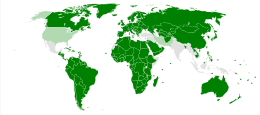Protocol II is a 1977 amendment protocol to the Geneva Conventions relating to the protection of victims of non-international armed conflicts. It defines certain international laws that strive to provide better protection for victims of internal armed conflicts that take place within the borders of a single country. The scope of these laws is more limited than those of the rest of the Geneva Conventions out of respect for sovereign rights and duties of national governments.

As of July 2024, the Protocol had been ratified by 169 countries, with the United States, India, Pakistan, Turkey, Iran, Iraq, Syria, and Israel being notable exceptions. However, the United States, Iran, and Pakistan signed it on 12 December 1977, which signifies an intention to work towards ratifying it.[3] The Iranian signature was given prior to the 1979 Iranian Revolution.
Overview
editHistorically, international law of armed conflict addressed traditional declarations of war between nations. When the Geneva Conventions were updated in 1949 after the Second World War, delegates sought to define certain minimum humanitarian standards to situations that had all the characteristics of war, without being an international war.[4]
These negotiations resulted in Article 3, common to all four of the basic treaties of the Geneva Conventions of 1949. Common Article 3 applies to armed conflicts that are not of an international character, but that are contained within the boundaries of a single country. It provides limited protection to victims, including:
- Persons taking no active part in hostilities should be treated humanely (including military persons who have ceased to be active as a result of sickness, injury, or detention).
- The wounded and sick shall be collected and cared for.
By the 1970s, diplomats were attempting to negotiate clarifications to the brief language of Article 3, and to extend the scope of international law to cover additional humanitarian rights in the context of internal conflicts. These efforts resulted in Protocol II of the Geneva Conventions. The debate over this protocol centered on two conflicting ideas.[5] First, that the distinction between internal and international armed conflict is artificial from the point of view of a victim. Humanitarian principles should apply regardless of the identity of the combatants. Second, that international law does not apply to non-international situations. A nation has sovereignty within its borders, and must not accept judgments by and orders from other countries. And Article 6, section 2, also prohibits collective punishment.
See also
edit- Geneva Conventions
- First Geneva Convention, on the treatment of battlefield casualties.
- Second Geneva Convention, on the treatment of casualties in war at sea.
- Third Geneva Convention, on the treatment of prisoners of war.
- Fourth Geneva Convention, on the treatment of civilians during wartime.
- Protocol I, a 1977 amendment adopted addressing the protection of victims in international conflicts.
- Protocol III, a 2005 amendment adopted specifying the adoption of the Red Crystal emblem.
References
edit- ^ "Signatory States". International Committee of the Red Cross. n.d. Retrieved 10 April 2019.
- ^ "States Parties". International Committee of the Red Cross. n.d. Retrieved 1 July 2020.
- ^ "Protocol Additional to the Geneva Conventions of 12 August 1949, and relating to the Protection of Victims of Non-International Armed Conflicts (Protocol II), 8 June 1977". International Committee of the Red Cross.
- ^ Pictet, Jean (1958). Geneva Conventions of 12 August 1949: Commentary. International Committee of the Red Cross. Retrieved 6 August 2009.
- ^ Levie, Howard (1987). The Law of non-international armed conflict: Protocol II to the 1949 Geneva convention. Martinus Nijhoff Publishers. ISBN 9024734916. Retrieved 6 August 2009.
External links
edit- Committee of the Red Cross: Full text of Protocol II with commentaries
- List of countries that have signed or ratified Protocol II
- International Review of the Red Cross, 1997 – No. 320 Archived 12 October 2004 at the Wayback Machine Special issue: 20th anniversary of the 1977 Additional Protocols
- President Reagan's message to the Senate on Protocols I & II Archived 7 March 2016 at the Wayback Machine